BUACC5933, Sem1-2019: Traditional Budgeting and Standard Costing Essay
VerifiedAdded on 2023/03/20
|13
|3675
|36
Essay
AI Summary
This essay, prepared for the BUACC5933 Cost and Management Accounting course, examines the continuing relevance of traditional budgeting and standard costing in the contemporary business environment. The essay begins by defining traditional budgeting as a fixed approach that sets expenditure and income plans and standard costing as a technique that uses pre-determined standards to analyze actual costs. It then delves into the objectives and benefits of these methods, highlighting their roles in achieving organizational goals, monitoring performance, and aiding in financial decision-making. The essay further discusses how these techniques are applied in the current business setting, noting their importance in cost control, performance assessment, and communication within organizations. The work also acknowledges criticisms of traditional budgeting and standard costing, such as their inflexibility and potential for distortion, while still emphasizing their widespread use and value in various industries. The essay concludes by reinforcing the significance of these methods for effective financial management and strategic planning.
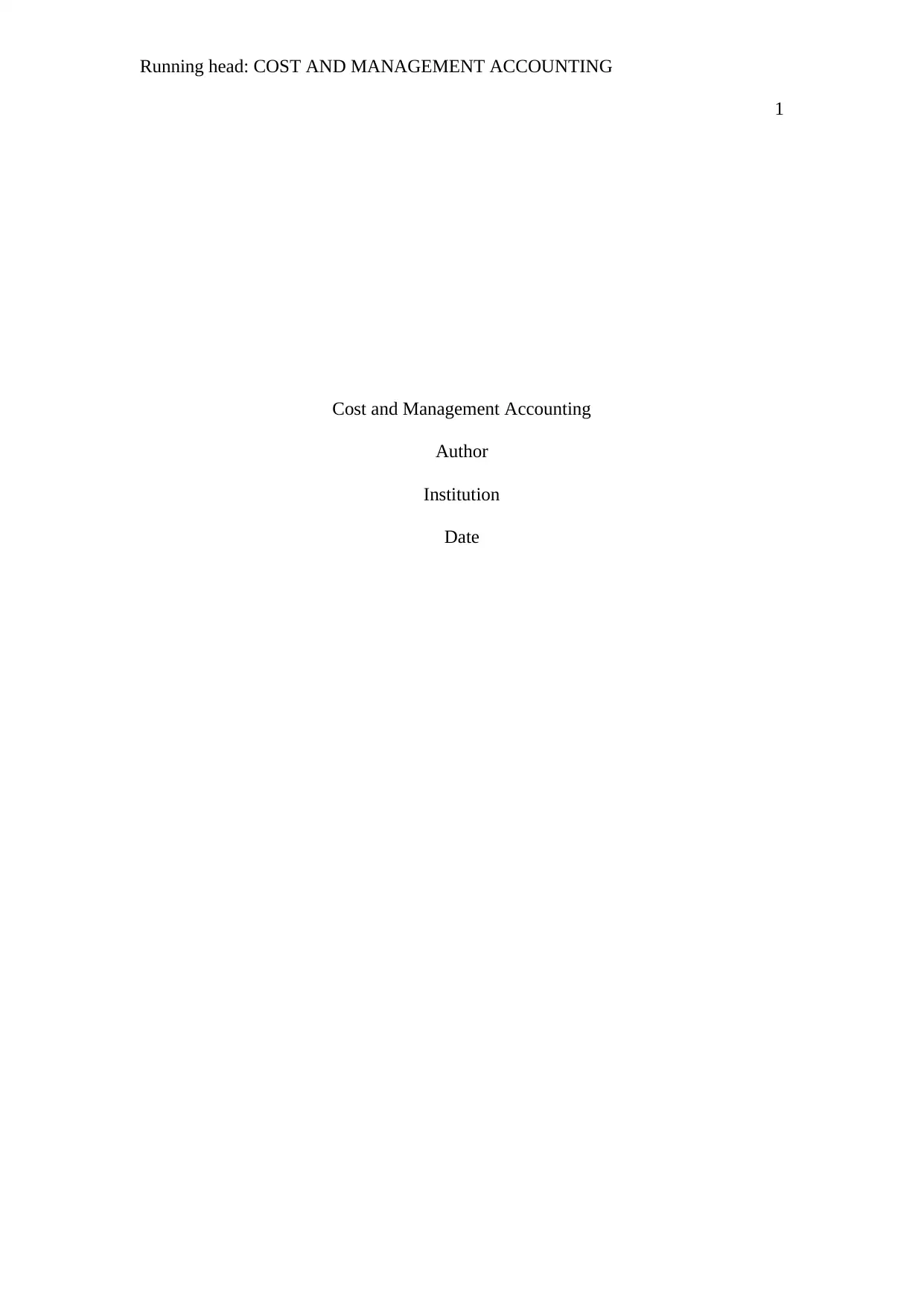
Running head: COST AND MANAGEMENT ACCOUNTING
1
Cost and Management Accounting
Author
Institution
Date
1
Cost and Management Accounting
Author
Institution
Date
Paraphrase This Document
Need a fresh take? Get an instant paraphrase of this document with our AI Paraphraser
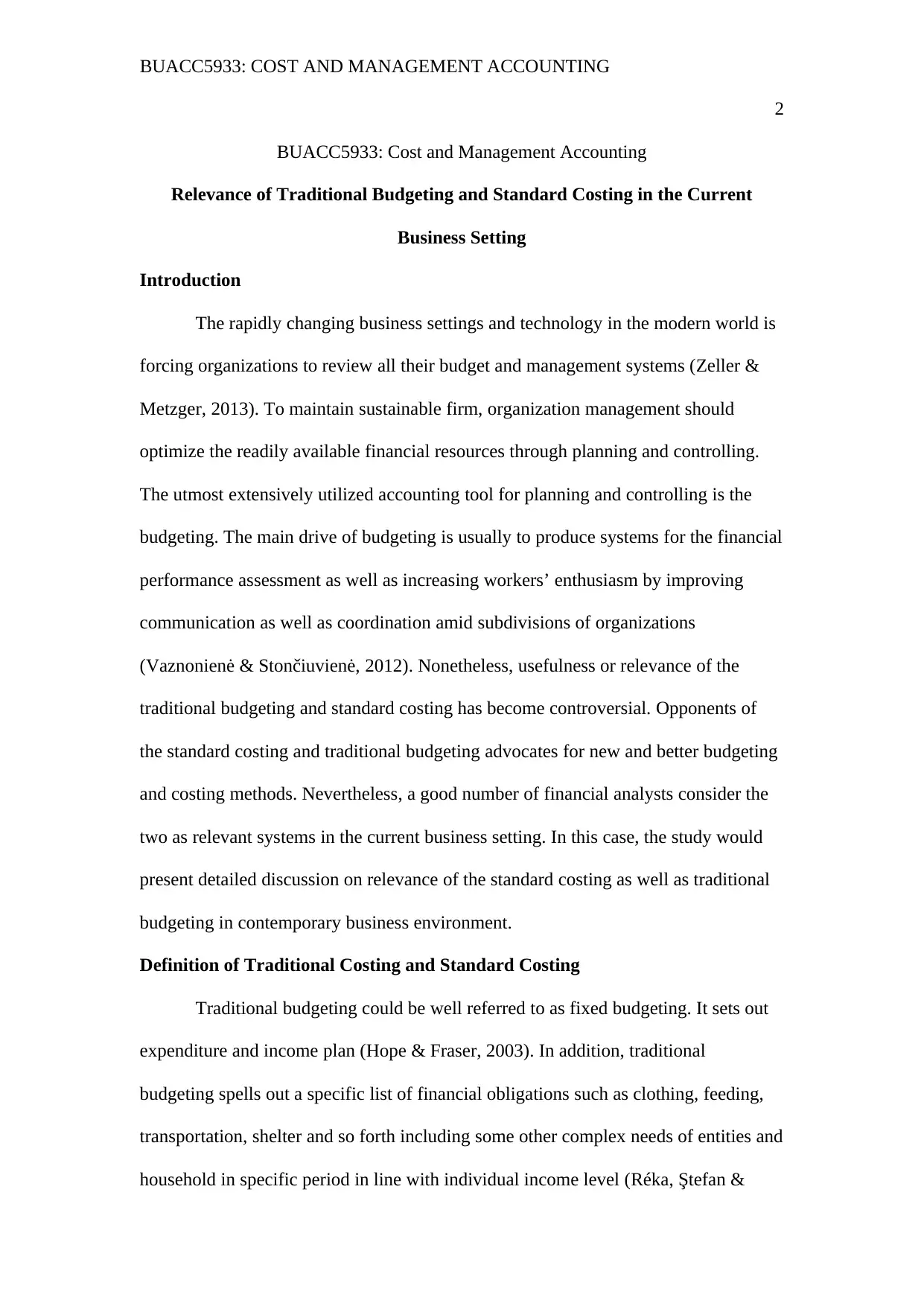
BUACC5933: COST AND MANAGEMENT ACCOUNTING
2
BUACC5933: Cost and Management Accounting
Relevance of Traditional Budgeting and Standard Costing in the Current
Business Setting
Introduction
The rapidly changing business settings and technology in the modern world is
forcing organizations to review all their budget and management systems (Zeller &
Metzger, 2013). To maintain sustainable firm, organization management should
optimize the readily available financial resources through planning and controlling.
The utmost extensively utilized accounting tool for planning and controlling is the
budgeting. The main drive of budgeting is usually to produce systems for the financial
performance assessment as well as increasing workers’ enthusiasm by improving
communication as well as coordination amid subdivisions of organizations
(Vaznonienė & Stončiuvienė, 2012). Nonetheless, usefulness or relevance of the
traditional budgeting and standard costing has become controversial. Opponents of
the standard costing and traditional budgeting advocates for new and better budgeting
and costing methods. Nevertheless, a good number of financial analysts consider the
two as relevant systems in the current business setting. In this case, the study would
present detailed discussion on relevance of the standard costing as well as traditional
budgeting in contemporary business environment.
Definition of Traditional Costing and Standard Costing
Traditional budgeting could be well referred to as fixed budgeting. It sets out
expenditure and income plan (Hope & Fraser, 2003). In addition, traditional
budgeting spells out a specific list of financial obligations such as clothing, feeding,
transportation, shelter and so forth including some other complex needs of entities and
household in specific period in line with individual income level (Réka, Ştefan &
2
BUACC5933: Cost and Management Accounting
Relevance of Traditional Budgeting and Standard Costing in the Current
Business Setting
Introduction
The rapidly changing business settings and technology in the modern world is
forcing organizations to review all their budget and management systems (Zeller &
Metzger, 2013). To maintain sustainable firm, organization management should
optimize the readily available financial resources through planning and controlling.
The utmost extensively utilized accounting tool for planning and controlling is the
budgeting. The main drive of budgeting is usually to produce systems for the financial
performance assessment as well as increasing workers’ enthusiasm by improving
communication as well as coordination amid subdivisions of organizations
(Vaznonienė & Stončiuvienė, 2012). Nonetheless, usefulness or relevance of the
traditional budgeting and standard costing has become controversial. Opponents of
the standard costing and traditional budgeting advocates for new and better budgeting
and costing methods. Nevertheless, a good number of financial analysts consider the
two as relevant systems in the current business setting. In this case, the study would
present detailed discussion on relevance of the standard costing as well as traditional
budgeting in contemporary business environment.
Definition of Traditional Costing and Standard Costing
Traditional budgeting could be well referred to as fixed budgeting. It sets out
expenditure and income plan (Hope & Fraser, 2003). In addition, traditional
budgeting spells out a specific list of financial obligations such as clothing, feeding,
transportation, shelter and so forth including some other complex needs of entities and
household in specific period in line with individual income level (Réka, Ştefan &
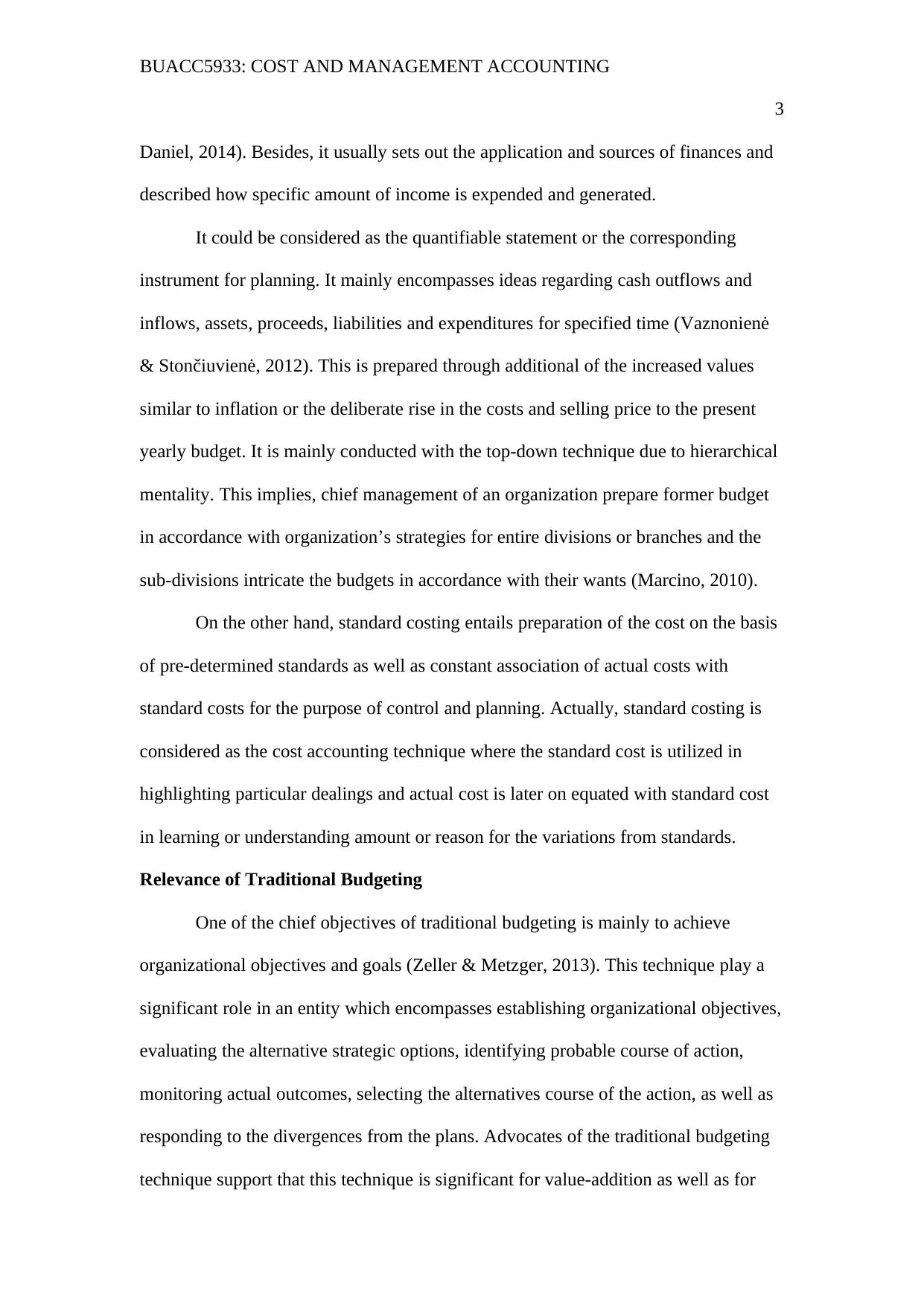
BUACC5933: COST AND MANAGEMENT ACCOUNTING
3
Daniel, 2014). Besides, it usually sets out the application and sources of finances and
described how specific amount of income is expended and generated.
It could be considered as the quantifiable statement or the corresponding
instrument for planning. It mainly encompasses ideas regarding cash outflows and
inflows, assets, proceeds, liabilities and expenditures for specified time (Vaznonienė
& Stončiuvienė, 2012). This is prepared through additional of the increased values
similar to inflation or the deliberate rise in the costs and selling price to the present
yearly budget. It is mainly conducted with the top-down technique due to hierarchical
mentality. This implies, chief management of an organization prepare former budget
in accordance with organization’s strategies for entire divisions or branches and the
sub-divisions intricate the budgets in accordance with their wants (Marcino, 2010).
On the other hand, standard costing entails preparation of the cost on the basis
of pre-determined standards as well as constant association of actual costs with
standard costs for the purpose of control and planning. Actually, standard costing is
considered as the cost accounting technique where the standard cost is utilized in
highlighting particular dealings and actual cost is later on equated with standard cost
in learning or understanding amount or reason for the variations from standards.
Relevance of Traditional Budgeting
One of the chief objectives of traditional budgeting is mainly to achieve
organizational objectives and goals (Zeller & Metzger, 2013). This technique play a
significant role in an entity which encompasses establishing organizational objectives,
evaluating the alternative strategic options, identifying probable course of action,
monitoring actual outcomes, selecting the alternatives course of the action, as well as
responding to the divergences from the plans. Advocates of the traditional budgeting
technique support that this technique is significant for value-addition as well as for
3
Daniel, 2014). Besides, it usually sets out the application and sources of finances and
described how specific amount of income is expended and generated.
It could be considered as the quantifiable statement or the corresponding
instrument for planning. It mainly encompasses ideas regarding cash outflows and
inflows, assets, proceeds, liabilities and expenditures for specified time (Vaznonienė
& Stončiuvienė, 2012). This is prepared through additional of the increased values
similar to inflation or the deliberate rise in the costs and selling price to the present
yearly budget. It is mainly conducted with the top-down technique due to hierarchical
mentality. This implies, chief management of an organization prepare former budget
in accordance with organization’s strategies for entire divisions or branches and the
sub-divisions intricate the budgets in accordance with their wants (Marcino, 2010).
On the other hand, standard costing entails preparation of the cost on the basis
of pre-determined standards as well as constant association of actual costs with
standard costs for the purpose of control and planning. Actually, standard costing is
considered as the cost accounting technique where the standard cost is utilized in
highlighting particular dealings and actual cost is later on equated with standard cost
in learning or understanding amount or reason for the variations from standards.
Relevance of Traditional Budgeting
One of the chief objectives of traditional budgeting is mainly to achieve
organizational objectives and goals (Zeller & Metzger, 2013). This technique play a
significant role in an entity which encompasses establishing organizational objectives,
evaluating the alternative strategic options, identifying probable course of action,
monitoring actual outcomes, selecting the alternatives course of the action, as well as
responding to the divergences from the plans. Advocates of the traditional budgeting
technique support that this technique is significant for value-addition as well as for
⊘ This is a preview!⊘
Do you want full access?
Subscribe today to unlock all pages.

Trusted by 1+ million students worldwide
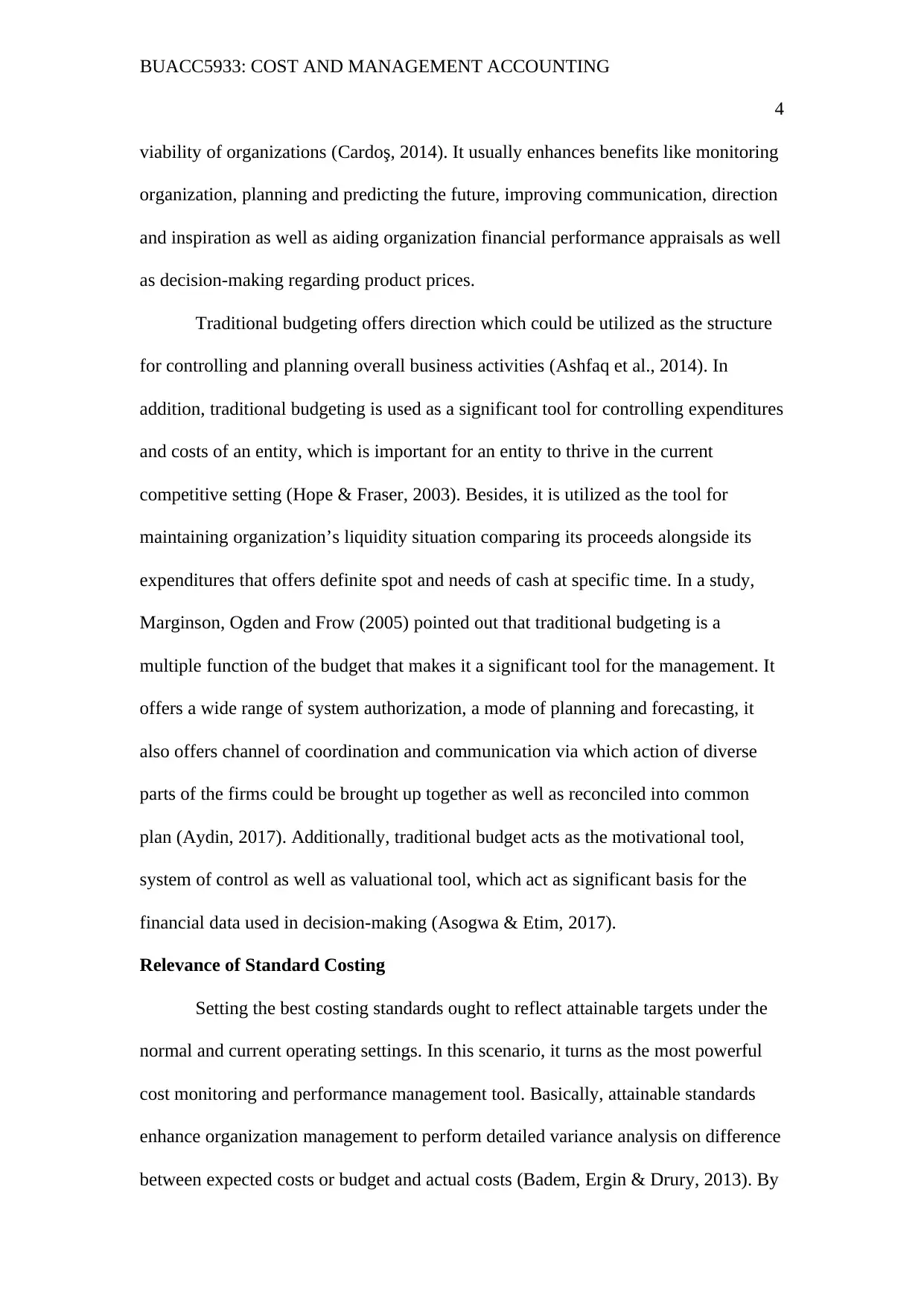
BUACC5933: COST AND MANAGEMENT ACCOUNTING
4
viability of organizations (Cardoş, 2014). It usually enhances benefits like monitoring
organization, planning and predicting the future, improving communication, direction
and inspiration as well as aiding organization financial performance appraisals as well
as decision-making regarding product prices.
Traditional budgeting offers direction which could be utilized as the structure
for controlling and planning overall business activities (Ashfaq et al., 2014). In
addition, traditional budgeting is used as a significant tool for controlling expenditures
and costs of an entity, which is important for an entity to thrive in the current
competitive setting (Hope & Fraser, 2003). Besides, it is utilized as the tool for
maintaining organization’s liquidity situation comparing its proceeds alongside its
expenditures that offers definite spot and needs of cash at specific time. In a study,
Marginson, Ogden and Frow (2005) pointed out that traditional budgeting is a
multiple function of the budget that makes it a significant tool for the management. It
offers a wide range of system authorization, a mode of planning and forecasting, it
also offers channel of coordination and communication via which action of diverse
parts of the firms could be brought up together as well as reconciled into common
plan (Aydin, 2017). Additionally, traditional budget acts as the motivational tool,
system of control as well as valuational tool, which act as significant basis for the
financial data used in decision-making (Asogwa & Etim, 2017).
Relevance of Standard Costing
Setting the best costing standards ought to reflect attainable targets under the
normal and current operating settings. In this scenario, it turns as the most powerful
cost monitoring and performance management tool. Basically, attainable standards
enhance organization management to perform detailed variance analysis on difference
between expected costs or budget and actual costs (Badem, Ergin & Drury, 2013). By
4
viability of organizations (Cardoş, 2014). It usually enhances benefits like monitoring
organization, planning and predicting the future, improving communication, direction
and inspiration as well as aiding organization financial performance appraisals as well
as decision-making regarding product prices.
Traditional budgeting offers direction which could be utilized as the structure
for controlling and planning overall business activities (Ashfaq et al., 2014). In
addition, traditional budgeting is used as a significant tool for controlling expenditures
and costs of an entity, which is important for an entity to thrive in the current
competitive setting (Hope & Fraser, 2003). Besides, it is utilized as the tool for
maintaining organization’s liquidity situation comparing its proceeds alongside its
expenditures that offers definite spot and needs of cash at specific time. In a study,
Marginson, Ogden and Frow (2005) pointed out that traditional budgeting is a
multiple function of the budget that makes it a significant tool for the management. It
offers a wide range of system authorization, a mode of planning and forecasting, it
also offers channel of coordination and communication via which action of diverse
parts of the firms could be brought up together as well as reconciled into common
plan (Aydin, 2017). Additionally, traditional budget acts as the motivational tool,
system of control as well as valuational tool, which act as significant basis for the
financial data used in decision-making (Asogwa & Etim, 2017).
Relevance of Standard Costing
Setting the best costing standards ought to reflect attainable targets under the
normal and current operating settings. In this scenario, it turns as the most powerful
cost monitoring and performance management tool. Basically, attainable standards
enhance organization management to perform detailed variance analysis on difference
between expected costs or budget and actual costs (Badem, Ergin & Drury, 2013). By
Paraphrase This Document
Need a fresh take? Get an instant paraphrase of this document with our AI Paraphraser
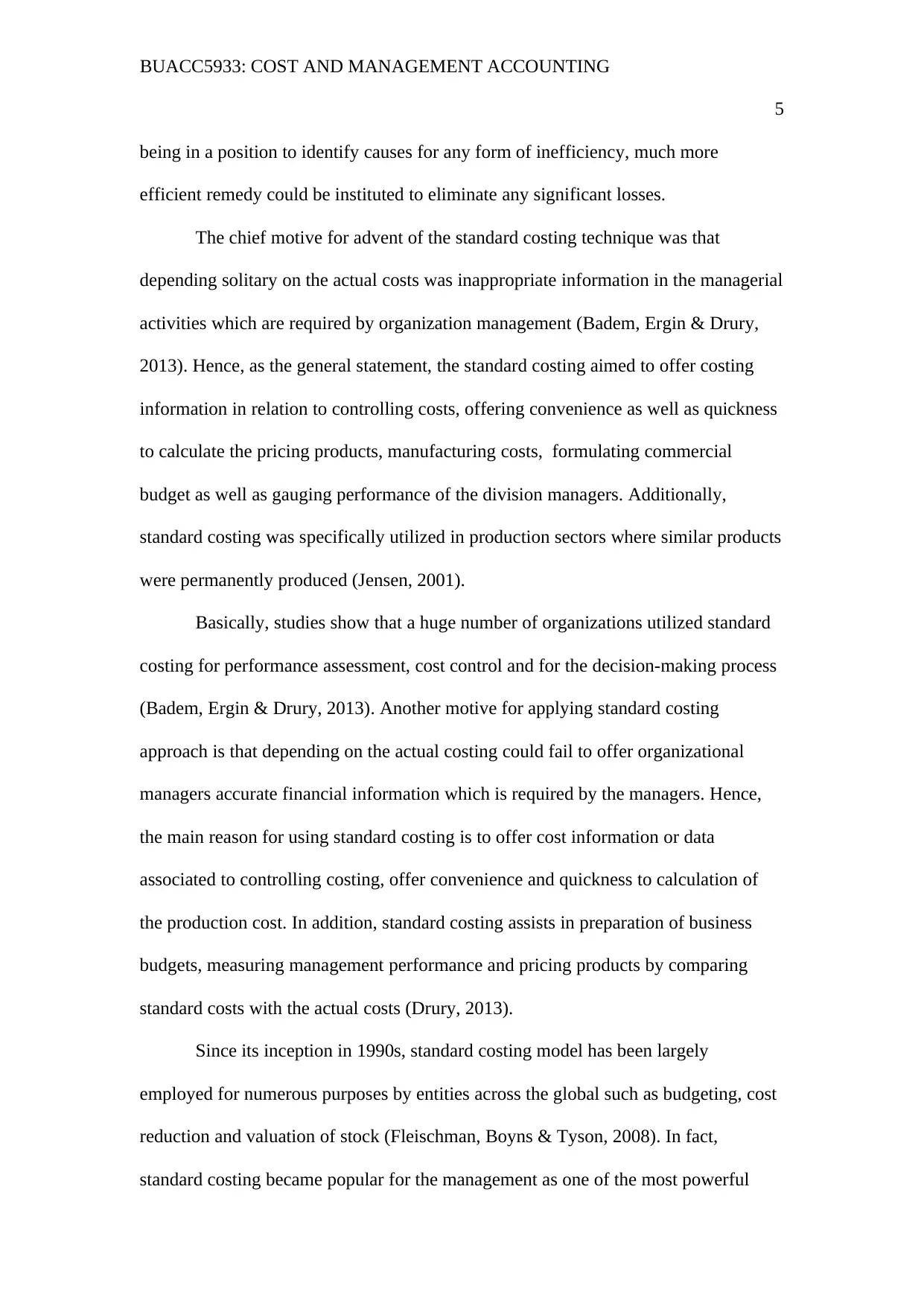
BUACC5933: COST AND MANAGEMENT ACCOUNTING
5
being in a position to identify causes for any form of inefficiency, much more
efficient remedy could be instituted to eliminate any significant losses.
The chief motive for advent of the standard costing technique was that
depending solitary on the actual costs was inappropriate information in the managerial
activities which are required by organization management (Badem, Ergin & Drury,
2013). Hence, as the general statement, the standard costing aimed to offer costing
information in relation to controlling costs, offering convenience as well as quickness
to calculate the pricing products, manufacturing costs, formulating commercial
budget as well as gauging performance of the division managers. Additionally,
standard costing was specifically utilized in production sectors where similar products
were permanently produced (Jensen, 2001).
Basically, studies show that a huge number of organizations utilized standard
costing for performance assessment, cost control and for the decision-making process
(Badem, Ergin & Drury, 2013). Another motive for applying standard costing
approach is that depending on the actual costing could fail to offer organizational
managers accurate financial information which is required by the managers. Hence,
the main reason for using standard costing is to offer cost information or data
associated to controlling costing, offer convenience and quickness to calculation of
the production cost. In addition, standard costing assists in preparation of business
budgets, measuring management performance and pricing products by comparing
standard costs with the actual costs (Drury, 2013).
Since its inception in 1990s, standard costing model has been largely
employed for numerous purposes by entities across the global such as budgeting, cost
reduction and valuation of stock (Fleischman, Boyns & Tyson, 2008). In fact,
standard costing became popular for the management as one of the most powerful
5
being in a position to identify causes for any form of inefficiency, much more
efficient remedy could be instituted to eliminate any significant losses.
The chief motive for advent of the standard costing technique was that
depending solitary on the actual costs was inappropriate information in the managerial
activities which are required by organization management (Badem, Ergin & Drury,
2013). Hence, as the general statement, the standard costing aimed to offer costing
information in relation to controlling costs, offering convenience as well as quickness
to calculate the pricing products, manufacturing costs, formulating commercial
budget as well as gauging performance of the division managers. Additionally,
standard costing was specifically utilized in production sectors where similar products
were permanently produced (Jensen, 2001).
Basically, studies show that a huge number of organizations utilized standard
costing for performance assessment, cost control and for the decision-making process
(Badem, Ergin & Drury, 2013). Another motive for applying standard costing
approach is that depending on the actual costing could fail to offer organizational
managers accurate financial information which is required by the managers. Hence,
the main reason for using standard costing is to offer cost information or data
associated to controlling costing, offer convenience and quickness to calculation of
the production cost. In addition, standard costing assists in preparation of business
budgets, measuring management performance and pricing products by comparing
standard costs with the actual costs (Drury, 2013).
Since its inception in 1990s, standard costing model has been largely
employed for numerous purposes by entities across the global such as budgeting, cost
reduction and valuation of stock (Fleischman, Boyns & Tyson, 2008). In fact,
standard costing became popular for the management as one of the most powerful
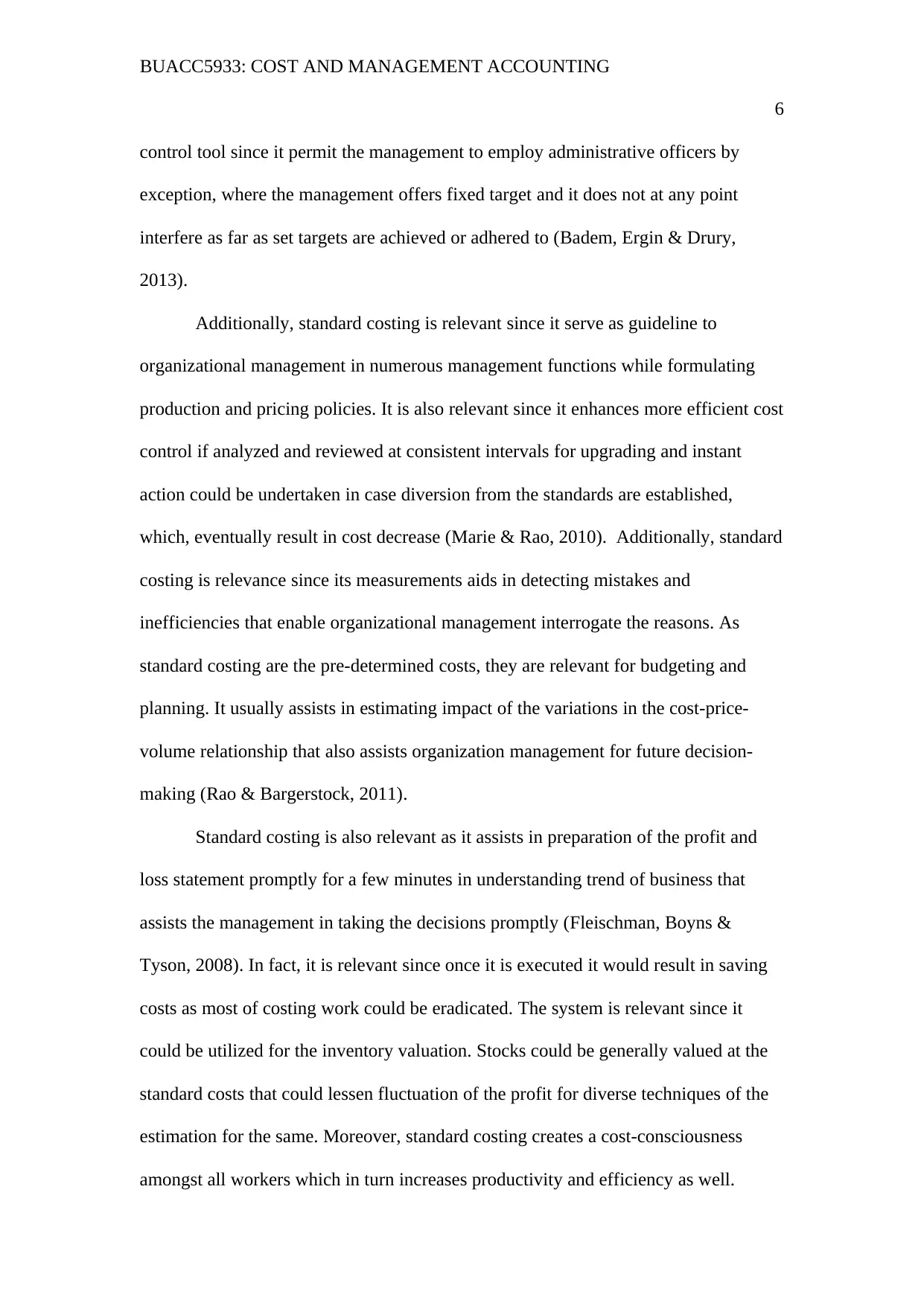
BUACC5933: COST AND MANAGEMENT ACCOUNTING
6
control tool since it permit the management to employ administrative officers by
exception, where the management offers fixed target and it does not at any point
interfere as far as set targets are achieved or adhered to (Badem, Ergin & Drury,
2013).
Additionally, standard costing is relevant since it serve as guideline to
organizational management in numerous management functions while formulating
production and pricing policies. It is also relevant since it enhances more efficient cost
control if analyzed and reviewed at consistent intervals for upgrading and instant
action could be undertaken in case diversion from the standards are established,
which, eventually result in cost decrease (Marie & Rao, 2010). Additionally, standard
costing is relevance since its measurements aids in detecting mistakes and
inefficiencies that enable organizational management interrogate the reasons. As
standard costing are the pre-determined costs, they are relevant for budgeting and
planning. It usually assists in estimating impact of the variations in the cost-price-
volume relationship that also assists organization management for future decision-
making (Rao & Bargerstock, 2011).
Standard costing is also relevant as it assists in preparation of the profit and
loss statement promptly for a few minutes in understanding trend of business that
assists the management in taking the decisions promptly (Fleischman, Boyns &
Tyson, 2008). In fact, it is relevant since once it is executed it would result in saving
costs as most of costing work could be eradicated. The system is relevant since it
could be utilized for the inventory valuation. Stocks could be generally valued at the
standard costs that could lessen fluctuation of the profit for diverse techniques of the
estimation for the same. Moreover, standard costing creates a cost-consciousness
amongst all workers which in turn increases productivity and efficiency as well.
6
control tool since it permit the management to employ administrative officers by
exception, where the management offers fixed target and it does not at any point
interfere as far as set targets are achieved or adhered to (Badem, Ergin & Drury,
2013).
Additionally, standard costing is relevant since it serve as guideline to
organizational management in numerous management functions while formulating
production and pricing policies. It is also relevant since it enhances more efficient cost
control if analyzed and reviewed at consistent intervals for upgrading and instant
action could be undertaken in case diversion from the standards are established,
which, eventually result in cost decrease (Marie & Rao, 2010). Additionally, standard
costing is relevance since its measurements aids in detecting mistakes and
inefficiencies that enable organizational management interrogate the reasons. As
standard costing are the pre-determined costs, they are relevant for budgeting and
planning. It usually assists in estimating impact of the variations in the cost-price-
volume relationship that also assists organization management for future decision-
making (Rao & Bargerstock, 2011).
Standard costing is also relevant as it assists in preparation of the profit and
loss statement promptly for a few minutes in understanding trend of business that
assists the management in taking the decisions promptly (Fleischman, Boyns &
Tyson, 2008). In fact, it is relevant since once it is executed it would result in saving
costs as most of costing work could be eradicated. The system is relevant since it
could be utilized for the inventory valuation. Stocks could be generally valued at the
standard costs that could lessen fluctuation of the profit for diverse techniques of the
estimation for the same. Moreover, standard costing creates a cost-consciousness
amongst all workers which in turn increases productivity and efficiency as well.
⊘ This is a preview!⊘
Do you want full access?
Subscribe today to unlock all pages.

Trusted by 1+ million students worldwide
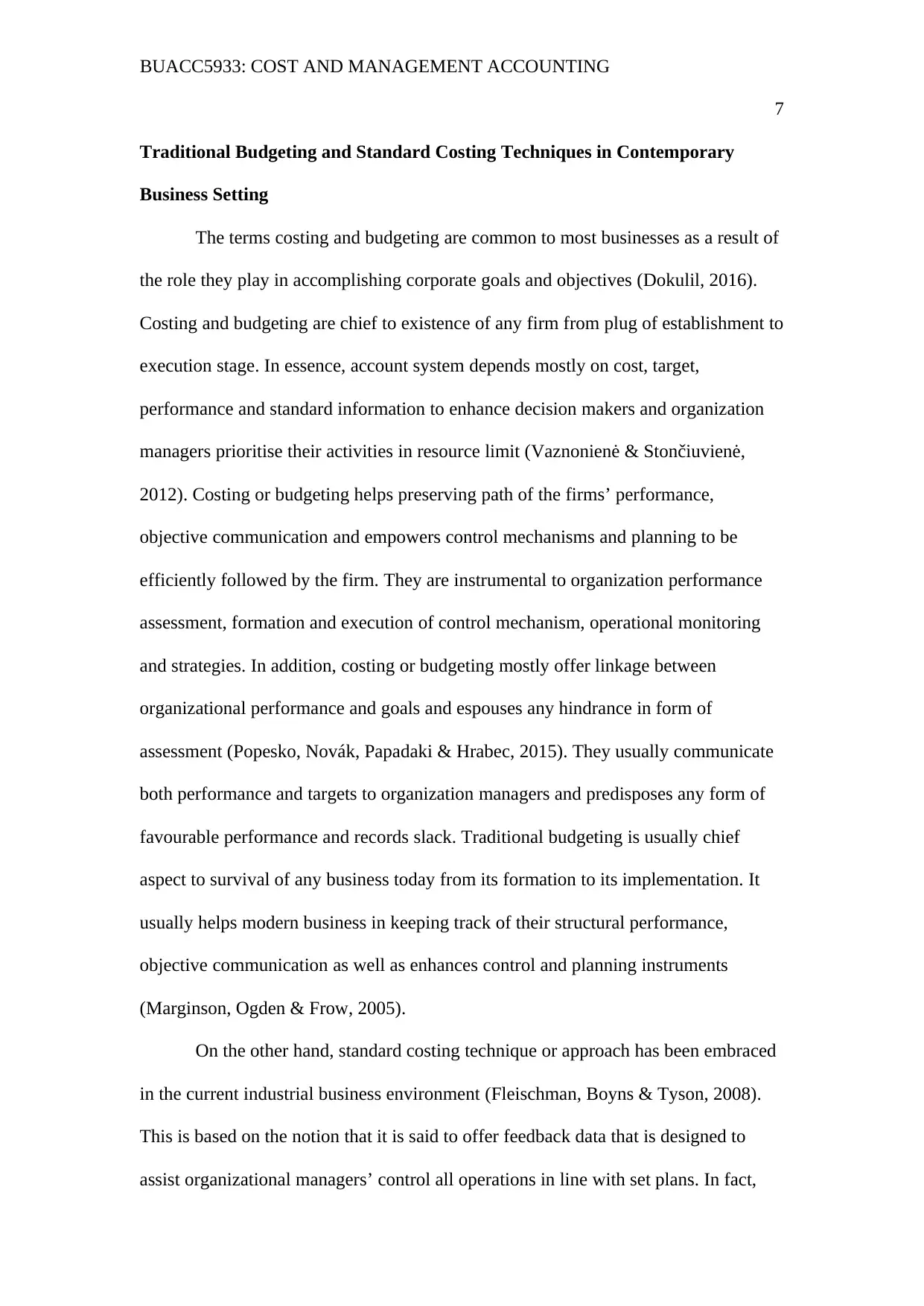
BUACC5933: COST AND MANAGEMENT ACCOUNTING
7
Traditional Budgeting and Standard Costing Techniques in Contemporary
Business Setting
The terms costing and budgeting are common to most businesses as a result of
the role they play in accomplishing corporate goals and objectives (Dokulil, 2016).
Costing and budgeting are chief to existence of any firm from plug of establishment to
execution stage. In essence, account system depends mostly on cost, target,
performance and standard information to enhance decision makers and organization
managers prioritise their activities in resource limit (Vaznonienė & Stončiuvienė,
2012). Costing or budgeting helps preserving path of the firms’ performance,
objective communication and empowers control mechanisms and planning to be
efficiently followed by the firm. They are instrumental to organization performance
assessment, formation and execution of control mechanism, operational monitoring
and strategies. In addition, costing or budgeting mostly offer linkage between
organizational performance and goals and espouses any hindrance in form of
assessment (Popesko, Novák, Papadaki & Hrabec, 2015). They usually communicate
both performance and targets to organization managers and predisposes any form of
favourable performance and records slack. Traditional budgeting is usually chief
aspect to survival of any business today from its formation to its implementation. It
usually helps modern business in keeping track of their structural performance,
objective communication as well as enhances control and planning instruments
(Marginson, Ogden & Frow, 2005).
On the other hand, standard costing technique or approach has been embraced
in the current industrial business environment (Fleischman, Boyns & Tyson, 2008).
This is based on the notion that it is said to offer feedback data that is designed to
assist organizational managers’ control all operations in line with set plans. In fact,
7
Traditional Budgeting and Standard Costing Techniques in Contemporary
Business Setting
The terms costing and budgeting are common to most businesses as a result of
the role they play in accomplishing corporate goals and objectives (Dokulil, 2016).
Costing and budgeting are chief to existence of any firm from plug of establishment to
execution stage. In essence, account system depends mostly on cost, target,
performance and standard information to enhance decision makers and organization
managers prioritise their activities in resource limit (Vaznonienė & Stončiuvienė,
2012). Costing or budgeting helps preserving path of the firms’ performance,
objective communication and empowers control mechanisms and planning to be
efficiently followed by the firm. They are instrumental to organization performance
assessment, formation and execution of control mechanism, operational monitoring
and strategies. In addition, costing or budgeting mostly offer linkage between
organizational performance and goals and espouses any hindrance in form of
assessment (Popesko, Novák, Papadaki & Hrabec, 2015). They usually communicate
both performance and targets to organization managers and predisposes any form of
favourable performance and records slack. Traditional budgeting is usually chief
aspect to survival of any business today from its formation to its implementation. It
usually helps modern business in keeping track of their structural performance,
objective communication as well as enhances control and planning instruments
(Marginson, Ogden & Frow, 2005).
On the other hand, standard costing technique or approach has been embraced
in the current industrial business environment (Fleischman, Boyns & Tyson, 2008).
This is based on the notion that it is said to offer feedback data that is designed to
assist organizational managers’ control all operations in line with set plans. In fact,
Paraphrase This Document
Need a fresh take? Get an instant paraphrase of this document with our AI Paraphraser
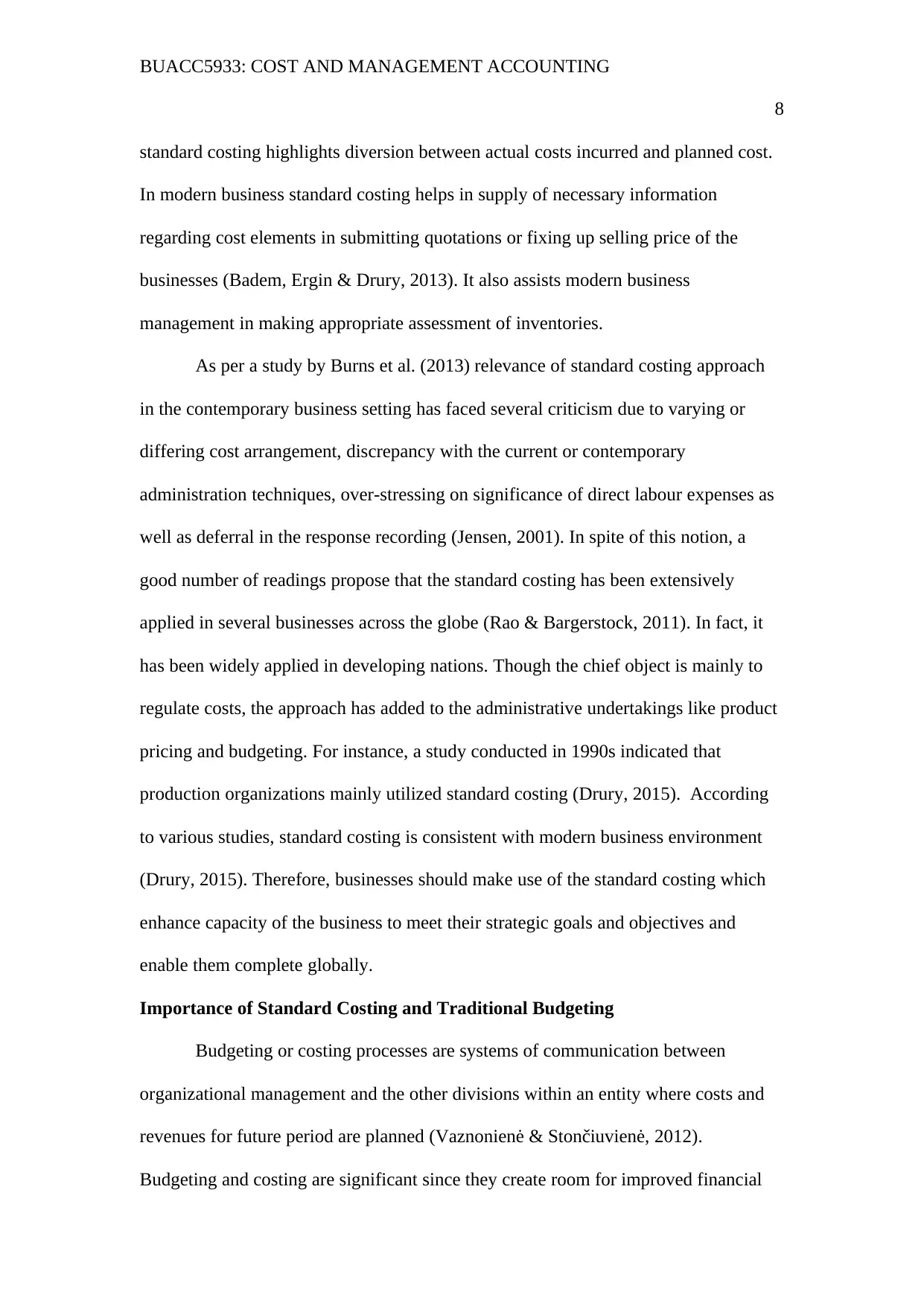
BUACC5933: COST AND MANAGEMENT ACCOUNTING
8
standard costing highlights diversion between actual costs incurred and planned cost.
In modern business standard costing helps in supply of necessary information
regarding cost elements in submitting quotations or fixing up selling price of the
businesses (Badem, Ergin & Drury, 2013). It also assists modern business
management in making appropriate assessment of inventories.
As per a study by Burns et al. (2013) relevance of standard costing approach
in the contemporary business setting has faced several criticism due to varying or
differing cost arrangement, discrepancy with the current or contemporary
administration techniques, over-stressing on significance of direct labour expenses as
well as deferral in the response recording (Jensen, 2001). In spite of this notion, a
good number of readings propose that the standard costing has been extensively
applied in several businesses across the globe (Rao & Bargerstock, 2011). In fact, it
has been widely applied in developing nations. Though the chief object is mainly to
regulate costs, the approach has added to the administrative undertakings like product
pricing and budgeting. For instance, a study conducted in 1990s indicated that
production organizations mainly utilized standard costing (Drury, 2015). According
to various studies, standard costing is consistent with modern business environment
(Drury, 2015). Therefore, businesses should make use of the standard costing which
enhance capacity of the business to meet their strategic goals and objectives and
enable them complete globally.
Importance of Standard Costing and Traditional Budgeting
Budgeting or costing processes are systems of communication between
organizational management and the other divisions within an entity where costs and
revenues for future period are planned (Vaznonienė & Stončiuvienė, 2012).
Budgeting and costing are significant since they create room for improved financial
8
standard costing highlights diversion between actual costs incurred and planned cost.
In modern business standard costing helps in supply of necessary information
regarding cost elements in submitting quotations or fixing up selling price of the
businesses (Badem, Ergin & Drury, 2013). It also assists modern business
management in making appropriate assessment of inventories.
As per a study by Burns et al. (2013) relevance of standard costing approach
in the contemporary business setting has faced several criticism due to varying or
differing cost arrangement, discrepancy with the current or contemporary
administration techniques, over-stressing on significance of direct labour expenses as
well as deferral in the response recording (Jensen, 2001). In spite of this notion, a
good number of readings propose that the standard costing has been extensively
applied in several businesses across the globe (Rao & Bargerstock, 2011). In fact, it
has been widely applied in developing nations. Though the chief object is mainly to
regulate costs, the approach has added to the administrative undertakings like product
pricing and budgeting. For instance, a study conducted in 1990s indicated that
production organizations mainly utilized standard costing (Drury, 2015). According
to various studies, standard costing is consistent with modern business environment
(Drury, 2015). Therefore, businesses should make use of the standard costing which
enhance capacity of the business to meet their strategic goals and objectives and
enable them complete globally.
Importance of Standard Costing and Traditional Budgeting
Budgeting or costing processes are systems of communication between
organizational management and the other divisions within an entity where costs and
revenues for future period are planned (Vaznonienė & Stončiuvienė, 2012).
Budgeting and costing are significant since they create room for improved financial
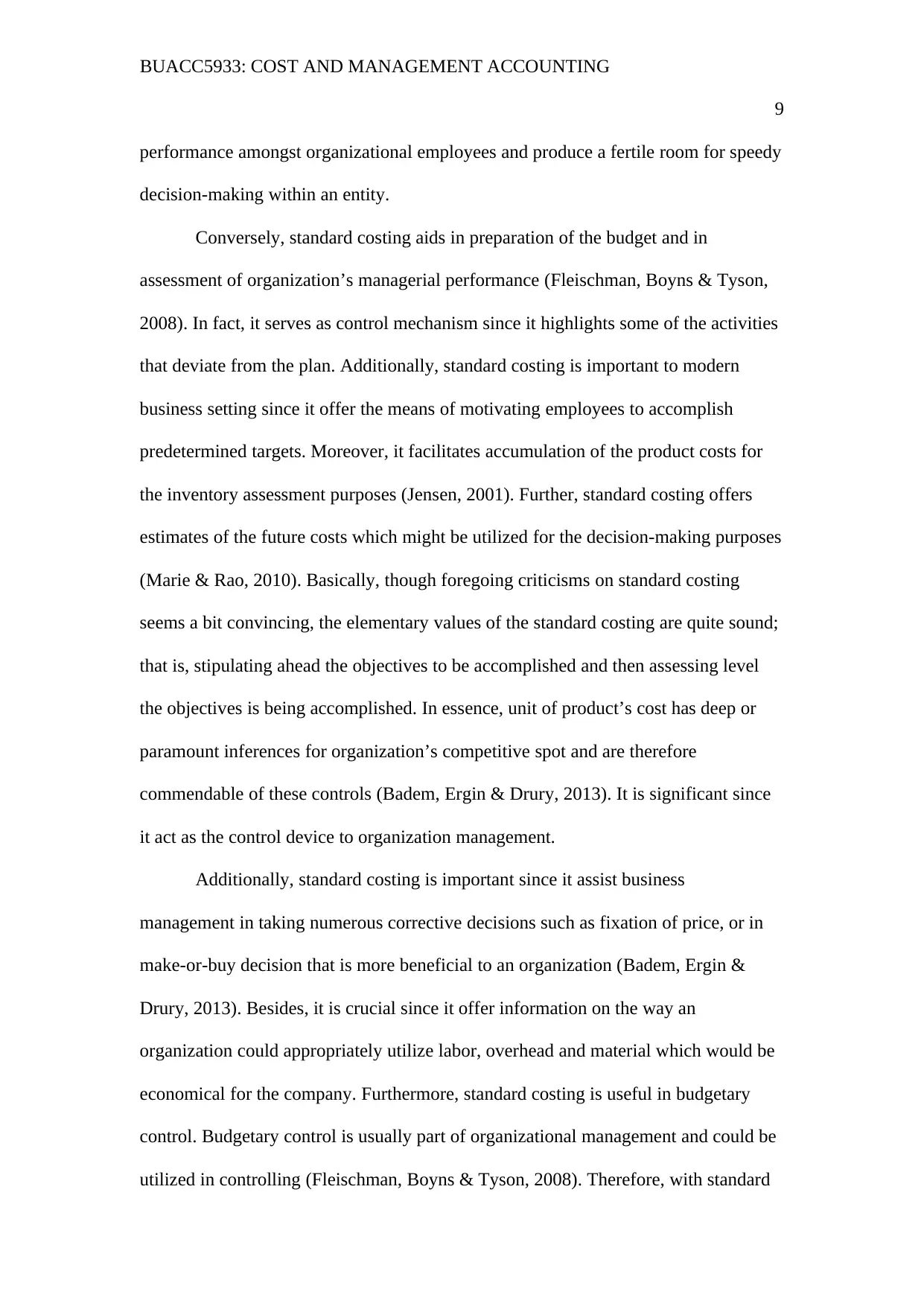
BUACC5933: COST AND MANAGEMENT ACCOUNTING
9
performance amongst organizational employees and produce a fertile room for speedy
decision-making within an entity.
Conversely, standard costing aids in preparation of the budget and in
assessment of organization’s managerial performance (Fleischman, Boyns & Tyson,
2008). In fact, it serves as control mechanism since it highlights some of the activities
that deviate from the plan. Additionally, standard costing is important to modern
business setting since it offer the means of motivating employees to accomplish
predetermined targets. Moreover, it facilitates accumulation of the product costs for
the inventory assessment purposes (Jensen, 2001). Further, standard costing offers
estimates of the future costs which might be utilized for the decision-making purposes
(Marie & Rao, 2010). Basically, though foregoing criticisms on standard costing
seems a bit convincing, the elementary values of the standard costing are quite sound;
that is, stipulating ahead the objectives to be accomplished and then assessing level
the objectives is being accomplished. In essence, unit of product’s cost has deep or
paramount inferences for organization’s competitive spot and are therefore
commendable of these controls (Badem, Ergin & Drury, 2013). It is significant since
it act as the control device to organization management.
Additionally, standard costing is important since it assist business
management in taking numerous corrective decisions such as fixation of price, or in
make-or-buy decision that is more beneficial to an organization (Badem, Ergin &
Drury, 2013). Besides, it is crucial since it offer information on the way an
organization could appropriately utilize labor, overhead and material which would be
economical for the company. Furthermore, standard costing is useful in budgetary
control. Budgetary control is usually part of organizational management and could be
utilized in controlling (Fleischman, Boyns & Tyson, 2008). Therefore, with standard
9
performance amongst organizational employees and produce a fertile room for speedy
decision-making within an entity.
Conversely, standard costing aids in preparation of the budget and in
assessment of organization’s managerial performance (Fleischman, Boyns & Tyson,
2008). In fact, it serves as control mechanism since it highlights some of the activities
that deviate from the plan. Additionally, standard costing is important to modern
business setting since it offer the means of motivating employees to accomplish
predetermined targets. Moreover, it facilitates accumulation of the product costs for
the inventory assessment purposes (Jensen, 2001). Further, standard costing offers
estimates of the future costs which might be utilized for the decision-making purposes
(Marie & Rao, 2010). Basically, though foregoing criticisms on standard costing
seems a bit convincing, the elementary values of the standard costing are quite sound;
that is, stipulating ahead the objectives to be accomplished and then assessing level
the objectives is being accomplished. In essence, unit of product’s cost has deep or
paramount inferences for organization’s competitive spot and are therefore
commendable of these controls (Badem, Ergin & Drury, 2013). It is significant since
it act as the control device to organization management.
Additionally, standard costing is important since it assist business
management in taking numerous corrective decisions such as fixation of price, or in
make-or-buy decision that is more beneficial to an organization (Badem, Ergin &
Drury, 2013). Besides, it is crucial since it offer information on the way an
organization could appropriately utilize labor, overhead and material which would be
economical for the company. Furthermore, standard costing is useful in budgetary
control. Budgetary control is usually part of organizational management and could be
utilized in controlling (Fleischman, Boyns & Tyson, 2008). Therefore, with standard
⊘ This is a preview!⊘
Do you want full access?
Subscribe today to unlock all pages.

Trusted by 1+ million students worldwide
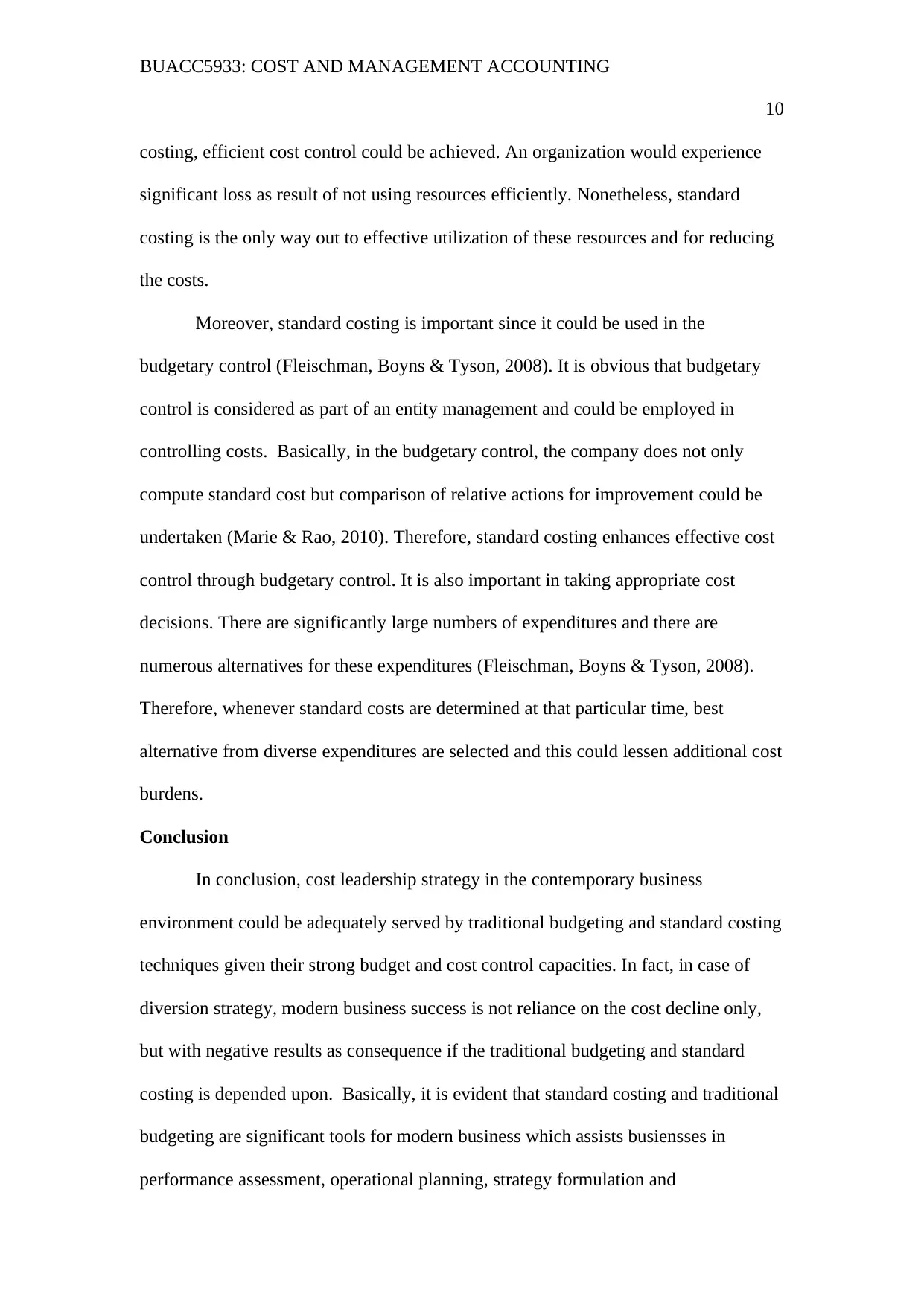
BUACC5933: COST AND MANAGEMENT ACCOUNTING
10
costing, efficient cost control could be achieved. An organization would experience
significant loss as result of not using resources efficiently. Nonetheless, standard
costing is the only way out to effective utilization of these resources and for reducing
the costs.
Moreover, standard costing is important since it could be used in the
budgetary control (Fleischman, Boyns & Tyson, 2008). It is obvious that budgetary
control is considered as part of an entity management and could be employed in
controlling costs. Basically, in the budgetary control, the company does not only
compute standard cost but comparison of relative actions for improvement could be
undertaken (Marie & Rao, 2010). Therefore, standard costing enhances effective cost
control through budgetary control. It is also important in taking appropriate cost
decisions. There are significantly large numbers of expenditures and there are
numerous alternatives for these expenditures (Fleischman, Boyns & Tyson, 2008).
Therefore, whenever standard costs are determined at that particular time, best
alternative from diverse expenditures are selected and this could lessen additional cost
burdens.
Conclusion
In conclusion, cost leadership strategy in the contemporary business
environment could be adequately served by traditional budgeting and standard costing
techniques given their strong budget and cost control capacities. In fact, in case of
diversion strategy, modern business success is not reliance on the cost decline only,
but with negative results as consequence if the traditional budgeting and standard
costing is depended upon. Basically, it is evident that standard costing and traditional
budgeting are significant tools for modern business which assists busiensses in
performance assessment, operational planning, strategy formulation and
10
costing, efficient cost control could be achieved. An organization would experience
significant loss as result of not using resources efficiently. Nonetheless, standard
costing is the only way out to effective utilization of these resources and for reducing
the costs.
Moreover, standard costing is important since it could be used in the
budgetary control (Fleischman, Boyns & Tyson, 2008). It is obvious that budgetary
control is considered as part of an entity management and could be employed in
controlling costs. Basically, in the budgetary control, the company does not only
compute standard cost but comparison of relative actions for improvement could be
undertaken (Marie & Rao, 2010). Therefore, standard costing enhances effective cost
control through budgetary control. It is also important in taking appropriate cost
decisions. There are significantly large numbers of expenditures and there are
numerous alternatives for these expenditures (Fleischman, Boyns & Tyson, 2008).
Therefore, whenever standard costs are determined at that particular time, best
alternative from diverse expenditures are selected and this could lessen additional cost
burdens.
Conclusion
In conclusion, cost leadership strategy in the contemporary business
environment could be adequately served by traditional budgeting and standard costing
techniques given their strong budget and cost control capacities. In fact, in case of
diversion strategy, modern business success is not reliance on the cost decline only,
but with negative results as consequence if the traditional budgeting and standard
costing is depended upon. Basically, it is evident that standard costing and traditional
budgeting are significant tools for modern business which assists busiensses in
performance assessment, operational planning, strategy formulation and
Paraphrase This Document
Need a fresh take? Get an instant paraphrase of this document with our AI Paraphraser
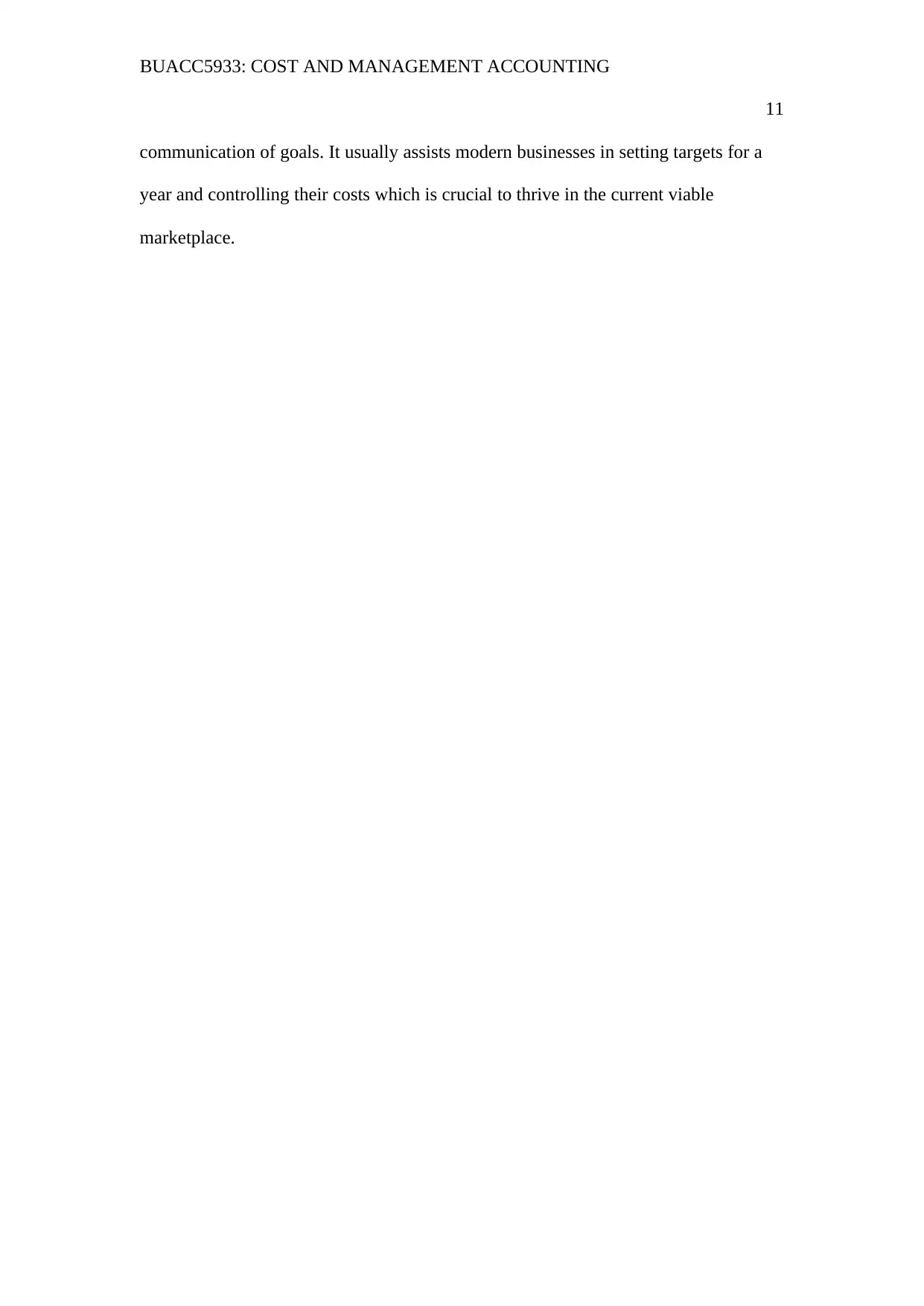
BUACC5933: COST AND MANAGEMENT ACCOUNTING
11
communication of goals. It usually assists modern businesses in setting targets for a
year and controlling their costs which is crucial to thrive in the current viable
marketplace.
11
communication of goals. It usually assists modern businesses in setting targets for a
year and controlling their costs which is crucial to thrive in the current viable
marketplace.
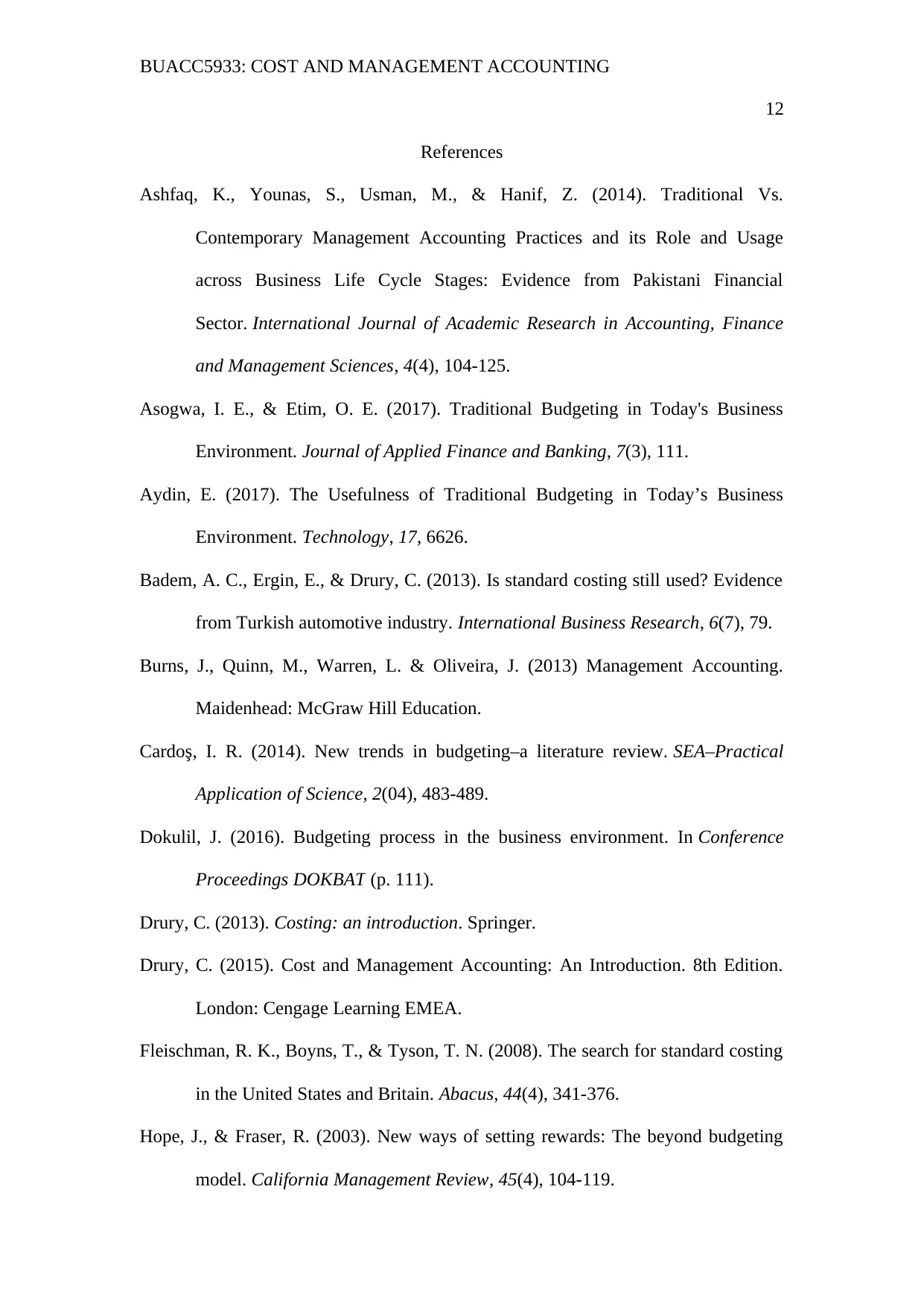
BUACC5933: COST AND MANAGEMENT ACCOUNTING
12
References
Ashfaq, K., Younas, S., Usman, M., & Hanif, Z. (2014). Traditional Vs.
Contemporary Management Accounting Practices and its Role and Usage
across Business Life Cycle Stages: Evidence from Pakistani Financial
Sector. International Journal of Academic Research in Accounting, Finance
and Management Sciences, 4(4), 104-125.
Asogwa, I. E., & Etim, O. E. (2017). Traditional Budgeting in Today's Business
Environment. Journal of Applied Finance and Banking, 7(3), 111.
Aydin, E. (2017). The Usefulness of Traditional Budgeting in Today’s Business
Environment. Technology, 17, 6626.
Badem, A. C., Ergin, E., & Drury, C. (2013). Is standard costing still used? Evidence
from Turkish automotive industry. International Business Research, 6(7), 79.
Burns, J., Quinn, M., Warren, L. & Oliveira, J. (2013) Management Accounting.
Maidenhead: McGraw Hill Education.
Cardoş, I. R. (2014). New trends in budgeting–a literature review. SEA–Practical
Application of Science, 2(04), 483-489.
Dokulil, J. (2016). Budgeting process in the business environment. In Conference
Proceedings DOKBAT (p. 111).
Drury, C. (2013). Costing: an introduction. Springer.
Drury, C. (2015). Cost and Management Accounting: An Introduction. 8th Edition.
London: Cengage Learning EMEA.
Fleischman, R. K., Boyns, T., & Tyson, T. N. (2008). The search for standard costing
in the United States and Britain. Abacus, 44(4), 341-376.
Hope, J., & Fraser, R. (2003). New ways of setting rewards: The beyond budgeting
model. California Management Review, 45(4), 104-119.
12
References
Ashfaq, K., Younas, S., Usman, M., & Hanif, Z. (2014). Traditional Vs.
Contemporary Management Accounting Practices and its Role and Usage
across Business Life Cycle Stages: Evidence from Pakistani Financial
Sector. International Journal of Academic Research in Accounting, Finance
and Management Sciences, 4(4), 104-125.
Asogwa, I. E., & Etim, O. E. (2017). Traditional Budgeting in Today's Business
Environment. Journal of Applied Finance and Banking, 7(3), 111.
Aydin, E. (2017). The Usefulness of Traditional Budgeting in Today’s Business
Environment. Technology, 17, 6626.
Badem, A. C., Ergin, E., & Drury, C. (2013). Is standard costing still used? Evidence
from Turkish automotive industry. International Business Research, 6(7), 79.
Burns, J., Quinn, M., Warren, L. & Oliveira, J. (2013) Management Accounting.
Maidenhead: McGraw Hill Education.
Cardoş, I. R. (2014). New trends in budgeting–a literature review. SEA–Practical
Application of Science, 2(04), 483-489.
Dokulil, J. (2016). Budgeting process in the business environment. In Conference
Proceedings DOKBAT (p. 111).
Drury, C. (2013). Costing: an introduction. Springer.
Drury, C. (2015). Cost and Management Accounting: An Introduction. 8th Edition.
London: Cengage Learning EMEA.
Fleischman, R. K., Boyns, T., & Tyson, T. N. (2008). The search for standard costing
in the United States and Britain. Abacus, 44(4), 341-376.
Hope, J., & Fraser, R. (2003). New ways of setting rewards: The beyond budgeting
model. California Management Review, 45(4), 104-119.
⊘ This is a preview!⊘
Do you want full access?
Subscribe today to unlock all pages.

Trusted by 1+ million students worldwide
1 out of 13
Related Documents
Your All-in-One AI-Powered Toolkit for Academic Success.
+13062052269
info@desklib.com
Available 24*7 on WhatsApp / Email
![[object Object]](/_next/static/media/star-bottom.7253800d.svg)
Unlock your academic potential
Copyright © 2020–2025 A2Z Services. All Rights Reserved. Developed and managed by ZUCOL.





